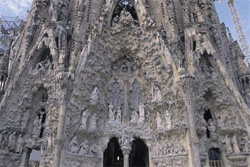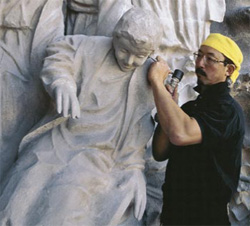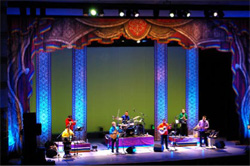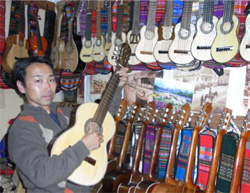Home > Highlighting JAPAN > Highlighting Japan DECEMBER 2012 > Variations on a Theme
Highlighting JAPAN
COVER STORY: Global Messengers—Sharing Japan's Strengths
Variations on a Theme
The world has great numbers of traditional cultures rooted in regional communities. Occasionally they fuse with other cultures and this causes them to grow. This article introduces two Japanese artists who are expressing their "passion without borders," in Spain and Bolivia respectively, cultivating traditional cultures while imparting a unique Japanese sensibility in their daily work.

Fifteen angel statues decorate the Nativity Façade. The Nativity Façade was registered on the list of World Heritage Properties in 2005.
Credit: COURTESY OF ETSURO SOTOO
The Basilica and Expiatory Church of the Holy Family in Barcelona is a building that epitomizes the works of Antoni Gaudí. Construction of this symbol of Barcelona, popularly known as the Sagrada Família, began in 1882. It is still under construction, with a plan for completion in the 2020s. Etsuro Sotoo is the longest serving staff member among some 200 architects, stonemasons and other experts directly involved in the construction.
Sotoo began working on the Sagrada Família as a sculptor in 1978, when he was twenty-five. Since then he has continued sculpting stones for the building by contracting each job from the Construction Board of La Sagrada Família Foundation, sometimes winning contests. After 34 years of continuous work, Sotoo finally became a regularly employed sculptor at the Sagrada Família in July 2012.
"One of my coworkers said to me, 'You certainly had a long apprenticeship,'" Sotoo recalls with a smile. "But I always did the jobs assigned to me feeling they were hiring me on a trial basis. I felt that way because as a foreigner I had to produce better work than my Spanish counterparts in order to win contracts."
Sotoo has produced many sculptures in the Sagrada Família. Fifteen angel statues that decorate the Nativity Façade are among his most important works there. When they were completed in 2000 after seventeen years of work they were praised as "angels that had been waiting to be carved from the stone."

Etsuro Sotoo at work with a hammer and chisel
Credit: COURTESY OF ETSURO SOTOO
"It would look strange if all angels have Caucasian faces," Sotoo points out. "There must be angels from the East, too."
Sotoo is currently working on three doors for the Nativity Façade. Seven sculptors from Barcelona took part in the competition for choosing the designs of the doors, and Sotoo's designs emerged as the winners.
The blueprints for the Sagrada Família were burned in the Spanish Civil War (1936–1939), and the models for the church were also destroyed. Contemporary architects and sculptors are therefore applying their own creativity to produce the building's design details based on Gaudí's ideas. Gaudí left no design instructions for doors of the Nativity Façade.
In the competition for the door designs, local sculptors proposed reliefs of Joseph, Mary and Jesus as decorative designs for the doors. In contrast, Sotoo proposed plants and flowers, such as ivy, reeds, irises and wild roses, and insects that visit them or live in them, such as ladybirds, caterpillars and stag beetles. Sotoo decided on these designs after considering the meaning of the story carved in the Nativity Façade and sculptures of animals and plants positioned in the Nativity Façade, and by actually observing natural inhabitants of the area, such as plants and insects.
"If you only look at Gaudí's works you just end up imitating him," Sotoo explains. "Imaging directions that Gaudí would go to is essential for creating something new. Gaudí had the philosophy of learning from and respecting nature. I expressed that philosophy in the doors."
Sotoo is working to create doors that rise to a height of five meters with a single bronze plate. Under normal conditions it is extremely difficult to produce a plate of such magnitude. Sotoo is aiming to realize the plate by using a technique known as V process casting, developed by a Japanese company, in which a vacuum pump is used to decompress sand and form a mold. He is also considering applying a technique developed in Spain for coloring the doors' surface.
"The year 2013 will be the 400th anniversary of Japan-Spain exchanges," Sotoo says. "I'd like to turn these doors into a symbol of friendship between the two countries."

Anata Bolivia in concert in Japan
Credit: COURTESY OF HIROYUKI AKIMOTO
Folclore is a traditional genre of Latin American music. "El Cóndor Pasa," well known for the rendition by Simon & Garfunkel, was originally a folclore song. A band called Anata Bolivia is very popular in Bolivia, the home of folclore. The leader of the band is a Japanese musician, Hiroyuki Akimoto.
Akimoto came across folclore when he was a university student. He immediately became fascinated by the genre. "At first I was attracted by the sound of the quena (a sort of recorder). It sounds somewhat like the shakuhachi, a Japanese traditional flute. To me it was both nostalgic and new," Akimoto recalls. After that, Akimoto began to play in bands and gradually became interested in learning about folclore in its home country. In 2000, after graduating from university, he moved to Bolivia at the age of twenty-two.
In La Paz, the capital, Akimoto met and asked famous folclore musician Juan Carlos to be his mentor. Carlos taught his Japanese protege the basics, such as how to keep time and create sounds. Realizing the importance of the basics, Akimoto memorized 100 folclore classics within a year.
"One day Juan said to me, "It's good to learn and play other people's music. But you must remember that music is also about expressing what is inside you." He told me I didn't have to pigeonhole myself into one specific form of music," Akimoto says. "This is when I broke away from existing styles and started exploring one of my own."

Hiroyuki Akimoto in his music store in La Paz
Credit: COURTESY OF HIROYUKI AKIMOTO
In 2009, Anata Bolivia was nominated for three Cicombol awards, including Album of the Year, Vocal Song of the Year, and Record of the Year. (Cicombol is the Bolivian version of the Grammy Awards.)
Wanting to convey the beauty of the Japanese language through folclore, Akimoto plays some Japanese songs in a folclore style with folclore instruments. The Japanese pop and folk songs Akimoto sings in his mother tongue have been well received by Bolivian audiences. "Many people from the audience thank me profusely for transcending national borders to perform their music," Akimoto says.
Along with being a performing musician, Akimoto runs a music store in La Paz and engages in volunteer activities, such as performing folclore for local children. This began when Akimoto visited an elementary school in La Paz as part of the activities of the culture group he belongs to. He was told to teach the children, in a lecture format, about certain serious topics, such as the purpose of life and peace. Just for a change, he began to sing folclore during the lecture. This made the children very excited. Since then, he has visited more than 100 schools, performing folclore and Japanese songs.
"We heard that folclore was becoming less familiar to Bolivian children than it was in the past. Being taught by a foreigner such as a Japanese may help renew their understanding about the value and diversity of folk music," says Akimoto. "We performed in Japan and many other countries in 2010 and 2011. I want to make Anata Bolivia an international band representing Bolivian folclore."
A New Treatment for Cancer
Dr. Hisataka Kobayashi (USA)
Dr. Hisataka Kobayashi, chief scientist of the U.S. National Institutes of Health, developed treatments that kill cancer cells without damaging healthy cells.

Chief Scientist Hisataka Kobayashi of the U.S. National Institutes of Health (NiH). Three of the four members of Dr. Kobayashi's research team who developed the cancer treatment method using near-infrared rays are Japanese nationals, including Dr. Kobayashi.
Credit: COURTESY OF DR. HISATAKA KOBAYASHI
In his January 2012 State of the Union address, President Barack Obama made this comment about an innovative cancer treatment. A research team led by Dr. Hisataka Kobayashi, chief scientist of the U.S. National Institutes of Health, developed this new treatment method.
"We had no idea that President Obama had mentioned our research activities in his State of the Union address," says Dr. Kobayashi. "Our associate told me immediately after the speech, which is how I found out about it for the first time. I was extremely happy."
The method Dr. Kobayashi's research team developed aims to only eradicate cancer cells, without harming other healthy cells in the body, by irradiating the cancer cells with near-infrared rays. The research results were announced in November 2011.
Methods to treat cancer include radiation and chemotherapy treatments in addition to surgery to remove cancer cells. However, these treatment methods have serious side effects, because healthy cells are harmed along with cancerous cells. That's why Dr. Kobayashi's research team uses near-infrared radiation, which doesn't harm the body.
How is it possible to eradicate cancer using near-infrared rays? In this treatment, chemical substances that emit heat-induced shock waves when irradiated with near-infrared rays are attached to an antibody that only binds to cancer cells, and this antibody is then delivered to cancer cells. It's like attaching a small piece of dynamite to cancer cells, then triggering the dynamite using a light called a near-infrared ray to blow out a part of the cell membrane and kill the cancer cells. This treatment is possible even when the cancer cells aren't visible or are scattered over several locations in the body or organ.
In tests on mice, an antibody was injected into ten mice into which cancer cells had been transplanted, and the mice were then irradiated with near-infrared rays eight times, twice every week. The cancer disappeared in eight of the mice, and they survived for over a year without a recurrence.
When these results were announced, the response was huge. The research was featured in major U.S. media outlets, and countless e-mails were sent to Dr. Kobayashi from friends, researchers, business entities, and others from all over the world.
"These research results can be applied to many different kinds of treatments and biotechnologies," says Dr. Kobayashi. "One example is the iPS cells developed by Professor Shinya Yamanaka of Kyoto University, who was recently awarded the Nobel Prize. This treatment method enables iPS cells to be used even more safely for regenerative medicine."
Dr. Kobayashi is now working on a plan to start clinical tests of infrared-ray cancer treatment methods within two years.
Making Cancer Cells Glow
For about eight years, from the late 1980s to the early 1990s, Dr. Kobayashi had worked as a radiologist at a hospital in Kyoto. He treated many cancer patients there. At the time, however, there weren't enough ways to effectively treat cancer, unlike nowadays.
"At the time, we were unable to save the lives of many cancer patients using radiation therapy," recalls Dr. Kobayashi. "This experience made me feel strongly that I had to do something new to treat cancer. To do this, I knew I needed to clarify what it was necessary to do. That's how I started researching cancer treatments."
In 1995, he went to the United States to work as a researcher at the National Institutes of Health, where the most cutting-edge cancer research in the world is conducted.
Another thing Dr. Kobayashi did in 2011, along with developing the near-infrared cancer treatment, was develop a fluorescent probe to make cancer cells glow. This research was conducted in conjunction with Professor Yasuteru Urano of the University of Tokyo. By spraying this reagent onto an area suspected to have cancer, in about a minute just the cancer cells start to glow. If this reagent is used, even the smallest cancer cells—just a few tenths of millimeters in size, which can't be detected by a PET, MRI, or CT scan—can't be missed. Clinical trials using this reagent are scheduled to begin within two years.
"I am very aware that I am a researcher and at the same time I am a physician," says Dr. Kobayashi. "I hope to save as many cancer patients as I can while I am capable of working as a physician, by putting the treatment and examination methods I have developed to practical use."
© 2009 Cabinet Office, Government of Japan






